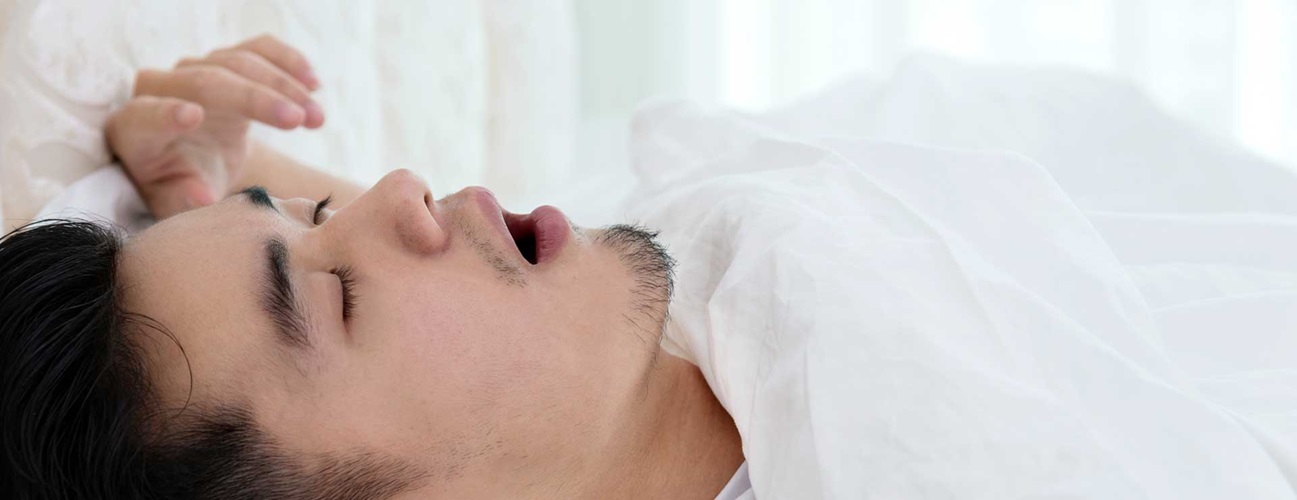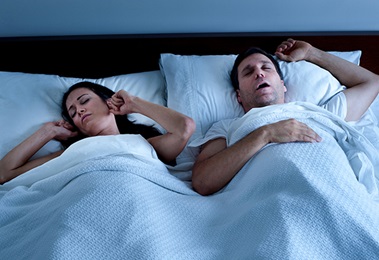Hypoglossal Nerve Stimulation Implant for Sleep Apnea
Featured Expert:
Hypoglossal nerve stimulation with an implanted device can help some people manage obstructive sleep apnea without a continuous positive airwave pressure (CPAP) machine. Kevin Motz, M.D., a Johns Hopkins sleep surgeon and laryngologist who specializes in sleep apnea, sheds light on the procedure.
What You Need to Know
- A hypoglossal nerve stimulator is an implantable device used to treat obstructive sleep apnea.
- The device detects each breath and sends an electrical impulse to stimulate the nerves that move the tongue and open the airway while the person sleeps.
- A hypoglossal nerve stimulation implant is an alternative for patients who cannot tolerate CPAP treatment.
What is hypoglossal nerve stimulation?
Hypoglossal nerve stimulation is a treatment for obstructive sleep apnea that uses an implant to stimulate a nerve under the tongue to prevent the tongue from blocking the airway. As of 2023, the only hypoglossal nerve stimulator that is approved by the Food and Drug Administration is the Inspire device. It has three parts that are surgically implanted in the neck and chest, and a remote to control the device.
How Hypoglossal Nerve Stimulation Helps with Sleep Apnea
Obstructive sleep apnea is caused by relaxation of muscles in the mouth and throat when a person is asleep. This muscle relaxation, especially in people with an unusually narrow airway, can cause a partial or complete blockage of airflow during sleep. Stimulation of these muscles during sleep is an evolving treatment approach for obstructive sleep apnea.
“Hypoglossal” means “under the tongue.” A hypoglossal nerve stimulation device sends a gentle electric pulse to a branch of the hypoglossal nerve. This causes the tongue to move forward, opening the airway with each breath.
Hypoglossal nerve stimulation aims to improve breathing, treat upper airway obstruction and reduce snoring, gasping and choking so the person can have a more restful sleep.
What is Hypoglossal Nerve Stimulation?
Hypoglossal Nerve Stimulator Device Parts
The hypoglossal nerve stimulator has the following:
- A breathing monitor, which is a small sensor that can detect when the person is breathing. It is at the end of a thin, flexible tube, and it is placed next to the ribs. With each breath, the monitor signals the pulse generator.
- A pulse generator, which is a flat disc about 1.5 inches across that sends a tiny electrical impulse to a cuff electrode when it gets the signal from the breathing monitor. The pulse generator is placed in the chest, below the collarbone. It connects to both the breathing monitor and the cuff electrode with thin wires.
- The cuff electrode fits around a branch of nerve under the tongue, like a tiny cuff. The electrode stimulates the nerves, which makes the tongue stick out. This clears the airway and allows the person to get a full breath without waking up.
The hypoglossal nerve stimulator implant is controlled by a hand-held remote that turns the device on and off. A delay feature allows you to set the nerve stimulator to start after you fall asleep.
Who might benefit from a hypoglossal nerve stimulator?
You may be a candidate for a hypoglossal nerve device if:
- You have moderate to severe sleep apnea ― an apnea-hypopnea index (AHI) score of 15 to 65. The AHI score is a measure of the times per hour that breathing stops or is incomplete due to partial airway obstruction.
- You tried using a CPAP machine but did not see improvement in your sleep, or you have been unable to sleep while using a CPAP.
- You have a body mass index (BMI) of 35 or less.
- You are healthy enough to tolerate a two-hour surgery.
Most insurance plans, including Medicare, will cover at least some of the costs of obtaining and using a hypoglossal nerve stimulator. Commercial insurance may only cover the procedure for people with a BMI of 32 or less.
Preparing for Hypoglossal Nerve Stimulator Placement Surgery
Your doctor will ask you questions about your sleep, your symptoms and your experience with a CPAP machine.
If you participated in a sleep study, you may be asked to provide paperwork regarding the study. A list of all medications that you take might also be requested, including over-the-counter medicines and supplements.
Endoscopy to Examine the Airway
If you and your doctor think you may be a candidate for hypoglossal nerve stimulation, the next step is a drug-induced sleep endoscopy.
This noninvasive test is performed while you are asleep under anesthesia, and it takes about a half-hour. A doctor inserts an endoscope, a thin flexible tube with a camera, into your nose, and the doctor sees if the airway relaxes and collapses in a way that the device would help.
Hypoglossal Nerve Stimulator Implantation
The surgery lasts two to three hours, and it is performed in an outpatient facility under general anesthesia ― you are asleep.
Preparing the Area
To help prevent infection, once you are asleep under anesthesia, the surgical team will gently scrub the skin of your chest and neck and paint the area with disinfectant to kill germs. The surgical area is then sealed with a plastic sheet.
Placing the Electrode
- The doctors make a small cut (about 4 centimeters) in the skin under the jaw.
- Muscle fibers are gently moved aside to gain access to the hypoglossal nerve under the tongue. The surgical team may use a microscope to gain a clearer picture of the area.
- Using small tools, the surgeons fit the electrode so it surrounds the nerve branches that control the tongue. Stitches (sutures) hold it in place.
Placing the Breathing Sensor and Pulse Generator
- The surgeons place the respiratory sensor lead in the muscles between the ribs, and then create a tunnel to connect the sensor and the electrode with a wire.
- They then insert the lead into the pulse generator, which is a flat, oblong disc about an inch and a half across.
- The connection is tested. If the device is properly connected and working, the tongue will stick out when the current comes on.
- The surgeons close the incisions layer by layer, with skin glue on top.
Once you awaken from the anesthesia in the recovery room and are cleared by your doctor, you may go home.
Surgery Complications
Infection is the most serious risk associated with this procedure. Other, rare complications include:
- Bleeding or blood vessel damage
- Nerve damage (weakness of the tongue)
- Allergy to the implant
- Scar tissue forming around the implant, which can make it difficult to remove the implant in the future
- Persistent pain, numbness or inflammation at the surgery sites
- Migration (movement) of the pulse generator or breathing sensor
- Pneumothorax (air that enters the chest cavity and collapses a lung)
Pleural effusion (fluid accumulating between the layers of tissue in the chest)
Recovery After Hypoglossal Nerve Stimulator Surgery
If you are sore after the procedure, over-the-counter pain relievers can help.
Call the doctor if you experience:
- Fever
- Pain that is not controlled by over-the-counter medication
- Redness or swelling at the incisions
- Bleeding
- Shortness of breath
After a few days of rest, you may be able to resume activities that are not strenuous. Follow your doctor’s recommendations about re-starting exercise or other physical activities, which is usually safe to do after about two weeks.
Activating and Using a Hypoglossal Nerve Stimulator
It takes about a month for the skin to heal after the implantation procedure. You will then be ready to have the system activated and to begin using it to improve your sleep.
Activating the device: You will return to your doctor about a month after the implant surgery to have the system turned on and adjusted.
Using the device: You will use a hand-held remote to turn the device on when you go to bed or take a nap. A delay setting helps ensure you are asleep before the stimulation begins.
Follow-up appointments: Once or twice each year, your doctor may adjust the device to be sure it is working well without waking you up.
Sleep study: You will need to have a sleep study to determine how well the hypoglossal nerve stimulation is reducing apnea episodes.
Scars: You will have two scars where the incisions heal — one under your chin and one on your chest below the collarbone. Each scar will be about 1 to 2 inches long.
Replacement parts: The pulse generator, the breathing sensor and the cuff electrode can remain in your body for many years. If they need to be removed for any reason, an outpatient procedure can be performed. The device runs on a battery that is designed to last about 11 years. The battery does not need charging. If it runs out of power, a doctor can replace it.
Hypoglossal Nerve Stimulation for Obstructive Sleep Apnea | David’s Story
Hypoglossal Nerve Stimulator Side Effects
Some people notice the following temporary side effects from using a hypoglossal nerve stimulator. If the side effects persist, talk to your doctor, who may make an adjustment to the device.
- Awareness of the stimulation
- Sore tongue
- Problems swallowing or speaking
- Abrasion (scraping) of the tongue surface from the tongue moving against the teeth
- Dry mouth
- Problems with the tongue muscle, including shrinkage and paralysis
Can you have an MRI if you have a hypoglossal nerve stimulation implant?
If you need an MRI, consult with the doctor who implanted your device. With some newer models of the hypoglossal nerve stimulation implants, an MRI can be performed with precautions. Be sure to let the MRI technologist know that you have the implant, and provide the technologist with all information requested.









